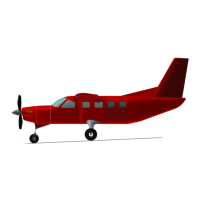FORWARD CABIN (COCKPIT) HEAT AND DEFOG
Forward cabin heat and defrost is provided through bleed air from the
engine, mixed with fresh air from the outside of the aircraft, or recycled air
from the cabin (depending on what source would provide the best air for the
function being performed). During heater operation, heated air is distributed
approximately 90% to the oor ducts, with the remaining air being diverted to
the windscreen defog ducts. When the Defog mode is selected, the majority
of the air is distributed to the windscreen. Temperature selection on the ECS
touch screen regulates the temperature of the defog air.
An emergency rewall fresh air shutoff valve is provided for shutting off the
supply of fresh air forward of the rewall. The valve is controlled by a red
knob located just below the right control wheel. To shut off the supply of
rewall forward fresh-air to the cabin, pull the red knob out fully.
The knob
may also be pulled out slightly to decrease the amount of fresh air entering
the system. This allows for a warmer outlet temperature for operating in cold
environments.
AFT CABIN (PASSENGER) HEAT
When additional heat is required in the aft cabin, the ight crew may select
the operation of individual electric heaters located in the side panels of the aft
cabin. Each heater can be individually activated as necessary, by accessing
the Heater zone section of the Temperature Conguration display. These
heaters are not subject to temperature regulation by the ACCS – they are
either selected as ON or OFF.
CABIN VENTILATION
Cabin ventilation is provided through two external fresh air inlets. One inlet
is located on the right side of the engine cowling and the other is located on
the right side of the dorsal n, just forward of the vertical tail. Each source
of ventilation contains a blower unit to provide forced air primarily for ground
operations.
AIR CONDITIONING (VAPOR CYCLE SYSTEM)
When air conditioning is necessary (if equipped), the aft and/or forward
evaporator blowers are actuated and air is distributed through the overhead
ceiling console vents in the aft cabin, and through the instrument panel vents
and foot well vents in the forward cockpit.
NOTE: The temperature of the defog air can only be reduced to the
ambient levels since the air conditioning is not active during the heat or
defog modes.

